The First Zeppelin Era
One of my more esoteric passions is airships. Born in 1951, I missed
the all-too-brief classic era of lighter-than-air aviation that ended
when the Zeppelin LZ 129
Hindenburg exploded while
landing at Lakehurst, New Jersey, at the end of a scheduled
transatlantic flight on May 6, 1937.
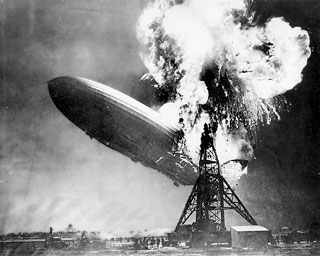
The Hindenburg explosion, May 6, 1937.
The closest I've came personally to the golden age of the great
dirigibles isn't very, only by proxy of sorts. My late mother saw the
British Vickers R-100
airship, which was three times the length of a Boeing 747 jumbo jet,
fly over the eastern Nova Scotia community where I live on its maiden
and only transatlantic trip from Cardington, England, to Montreal and
back in July/August 1930 - and a friend who is a retired colonel in the
Canadian Armed Forces and fellow airship aficionado once had an office
in Saint-Hubert, Quebec, that overlooked the site of the R-100's
docking mast. The R-100 also made a side-trip to Ottawa, Toronto, and
Niagara Falls during her two-week stay in Canada.
Thus one of my life's regrets has been that I missed out on flying
in a dirigible. It's not a disappointment that keeps me awake nights,
but it is encouraging to learn that dirigibles are making a bit of a
comeback in the 21st century.
It's unfortunate that newsreel images of Hindenburg's
spectacular conflagration are the principal impression of airships that
is etched in most people's synapses (if they think about airships at
all), while largely forgotten is that Hindenburg's predecessor,
LZ 127
Graf Zeppelin, operated commercially from 1928 to 1937,
making 590 flights including 64 regularly scheduled ones across the
South Atlantic from Frankfurt to Brazil, one circumnavigation, a polar
expedition, two round trips to the Middle East, several within Europe,
and five to the United States (two of them during the "Round the World
Flight"), safely covering more than a million miles.
USS Macon in flight.
Incidentally. the US Navy commissioned a Zeppellin-built airship,
the LZ-126 USS Los
Angeles, which was acquired from the German government in 1924
as part of war reparations from World War I. Like the bigger Graf
Zeppelin, USS Los Angeles had a successful and safe career
logging a total of 4,398 hours of operational flight, covering a
distance of 172,400 nautical miles serving as an observatory,
experimental platform, and training ship for other airships, including
the US-built (but less successful) dirigible USS Akron
and USS
Macon, eventually being retired and dismantled for
scrap in 1939.
USS Macon over San Francisco.
The ZRS-4 USS Akron was constructed in Akron, Ohio, by the
Goodyear-Zeppelin Corp., commissioned on October 27, 1931, and crashed
in a storm off the New Jersey coast on April 4, 1933 with the loss of
73 crew. Akron's sister-ship, USS Macon, was commissioned June
23, 1933 and also went down in a storm, this time off California's Big
Sur coast, on February 3, 1935, although happily all but two of her
crew survived.
USS Akron and USS Macon were intended to serve as a
flying aircraft carriers with internal hangars carrying Sparrowhawk biplanes
that could be launched and retrieved in flight using a trapeze.
Modern Zeppelins
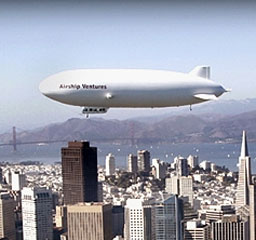
Now, you may be wondering if there's any Apple-related relevance to
this ramble, and actually there is - or at least a Steve Jobs/Pixar
connection.
A Moffet Field, California, based startup called Airship Ventures has begun
chartering a 12-passenger Zeppelin airship for daily sightseeing
flights, advertising operations, corporate and event occasions, and
scientific missions in the San Francisco Bay Area. Company founders and
married couple Alex and Brian Hall say they want to make money while
making people smile. Brian Hall's previous venture was Mark/Space, a successful company
offering software to move data between mobile phones and computers.
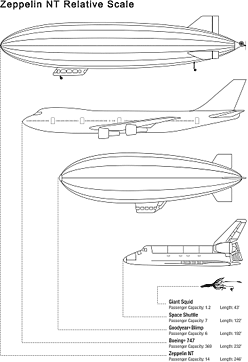 The
Halls' $15 million. 246-foot-long dirigible airship (15 feet longer
than a Boeing 747, and it's not a blimp) Eureka is a the fourth
Zeppelin NT (the largest airship since the 1930s giants) to be built,
designed exclusively for passenger operations by Zeppelin Luftschifftechnik GmbH
(ZLT) of Friedrichshafen, Germany, successor firm to the Luftschiff
Zeppelin company that built the USS Los Angeles, Graf Zeppelin,
and Hindenburg back in the 1920s and '30s. Eureka has a top
speed of 77 mph with a maximum flight range of 500 nautical miles.
The
Halls' $15 million. 246-foot-long dirigible airship (15 feet longer
than a Boeing 747, and it's not a blimp) Eureka is a the fourth
Zeppelin NT (the largest airship since the 1930s giants) to be built,
designed exclusively for passenger operations by Zeppelin Luftschifftechnik GmbH
(ZLT) of Friedrichshafen, Germany, successor firm to the Luftschiff
Zeppelin company that built the USS Los Angeles, Graf Zeppelin,
and Hindenburg back in the 1920s and '30s. Eureka has a top
speed of 77 mph with a maximum flight range of 500 nautical miles.
Incidentally and importantly, Eureka uses the inert and safe
nonflammable gas helium for lift rather than the hydrogen used in
Graf Zeppelin and Hindenburg. Zeppelin-NT ships have an
excellent global safety record, carrying more than 80,000 passengers
since August 2001, without a single incident.
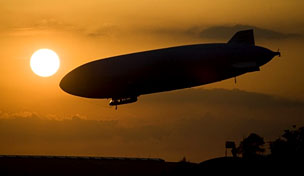
Photo by Achim Mende
The Halls launched their airship service last October, making it the
first commercial passenger airship in the US since the
Hindenburg's spectacular 1937 demise, and are now flying several
full flights a day. Rental for the Zeppelin, which comes staffed with a
pilot and steward, costs about $5,000 an hour. Turning the airship into
a flying billboard costs about $100,000 a month. And for $750,000 a
month, you can brand and charter the whole thing. Disney-Pixar has
hired Airship Ventures to help promote its newest film release:
UP.
"The decal material in this branding is equal to about 17
billboards," comments Airship Ventures' Alex Hall. "Since our Zeppelin
arrived last October, we've been touting our wonderful luxury
flight-seeing experience. But when the opportunity arose to feature
Disney-Pixar's 'UP,' which even has a fantasy Zeppelin in it, we could
hardly say no!"
 Earlier this year
Eureka was put through her paces for Skywalker Sound to make
sound recordings that will form the foundation for the airship
soundtrack in the movie, Ms. Hall noting that "We were very pleased to
be able to help Disney-Pixar with this request, and while it wasn't a
starring role, we think Hollywood will develop a soft spot for our
'leading lady' when we visit later this month!"
Earlier this year
Eureka was put through her paces for Skywalker Sound to make
sound recordings that will form the foundation for the airship
soundtrack in the movie, Ms. Hall noting that "We were very pleased to
be able to help Disney-Pixar with this request, and while it wasn't a
starring role, we think Hollywood will develop a soft spot for our
'leading lady' when we visit later this month!"
Disney-Pixar's "UP," is an animated comedy adventure directed by
Academy Award-nominated Pete Docter about 78-year-old balloon salesman
Carl Fredricksen, who finally fulfills his lifelong dream of a great
adventure when he ties thousands of balloons to his house and flies
away to the wilds of South America, only to discover all too late that
his biggest nightmare has stowed away on the trip in the form of an
overly-optimistic 8-year-old wilderness explorer named Russell.
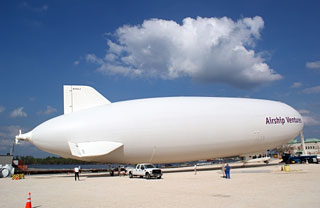 UP will be presented in Disney Digital 3-D beginning May
29, but Airship Venture's Eureka is already floating around the
Bay Area with branding that promotes the film. "We're becoming part of
the scenery around here," Ms. Hall says. "We've often said that we'll
know that we've made it when you go to Fisherman's Wharf and you can
buy a T-shirt with the airship and the Golden Gate Bridge."
UP will be presented in Disney Digital 3-D beginning May
29, but Airship Venture's Eureka is already floating around the
Bay Area with branding that promotes the film. "We're becoming part of
the scenery around here," Ms. Hall says. "We've often said that we'll
know that we've made it when you go to Fisherman's Wharf and you can
buy a T-shirt with the airship and the Golden Gate Bridge."
California Cruises offered by Airship Ventures feature 8 to 10 hours
in the air (depending on winds), giving you plenty of time to gaze at
the amazingly varied views of California, with a route taken partially
down the coast and partially inland, passing everything from suburban
sprawl and agricultural landscapes to ocean, mountains and forests with
plenty of food and beverages laid on in the comfortable gondola which
includes a restroom with a window.
Pricing for tours from Moffett Field to Long Beach and back is one
way - $1,500, and round trip $2,500, plus taxes. Scenic "flight-seeing"
tours are also offered aboard Eureka from Moffett Field, Oakland
International Airport, and Monterey Bay starting at $495 or with the
promotion discounted to less than $375 plus taxes per person.
Who knows? Perhaps one day I'll get my chance to fly in a Zeppelin
after all!



 The
Halls' $15 million. 246-foot-long dirigible airship (15 feet longer
than a Boeing 747, and it's not a blimp) Eureka is a the fourth
Zeppelin NT (the largest airship since the 1930s giants) to be built,
designed exclusively for passenger operations by
The
Halls' $15 million. 246-foot-long dirigible airship (15 feet longer
than a Boeing 747, and it's not a blimp) Eureka is a the fourth
Zeppelin NT (the largest airship since the 1930s giants) to be built,
designed exclusively for passenger operations by 
 Earlier this year
Eureka was put through her paces for Skywalker Sound to make
sound recordings that will form the foundation for the airship
soundtrack in the movie, Ms. Hall noting that "We were very pleased to
be able to help Disney-Pixar with this request, and while it wasn't a
starring role, we think Hollywood will develop a soft spot for our
'leading lady' when we visit later this month!"
Earlier this year
Eureka was put through her paces for Skywalker Sound to make
sound recordings that will form the foundation for the airship
soundtrack in the movie, Ms. Hall noting that "We were very pleased to
be able to help Disney-Pixar with this request, and while it wasn't a
starring role, we think Hollywood will develop a soft spot for our
'leading lady' when we visit later this month!" UP will be presented in Disney Digital 3-D beginning May
29, but Airship Venture's Eureka is already floating around the
Bay Area with branding that promotes the film. "We're becoming part of
the scenery around here," Ms. Hall says. "We've often said that we'll
know that we've made it when you go to Fisherman's Wharf and you can
buy a T-shirt with the airship and the Golden Gate Bridge."
UP will be presented in Disney Digital 3-D beginning May
29, but Airship Venture's Eureka is already floating around the
Bay Area with branding that promotes the film. "We're becoming part of
the scenery around here," Ms. Hall says. "We've often said that we'll
know that we've made it when you go to Fisherman's Wharf and you can
buy a T-shirt with the airship and the Golden Gate Bridge."
